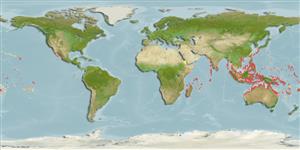>
Eupercaria/misc (Various families in series Eupercaria) >
Labridae (Wrasses) > Cheilininae
Etymology: Cymolutes: Greek, kymo = waves + Greek, lytes, lyto = to liberate.
More on author: Valenciennes.
Environment: milieu / climate zone / depth range / distribution range
Ökologie
seewasser riff-verbunden; tiefenbereich 2 - 20 m (Ref. 37816), usually 6 - ? m (Ref. 48636). Tropical; 32°N - 32°S
Indo-Pacific: East Africa to New Britain and the Marquesan (?) Islands, north to southern Japan, south to Lord Howe Island.
Size / Gewicht / Alter
Maturity: Lm ? range ? - ? cm
Max length : 20.0 cm TL Männchen/unbestimmt; (Ref. 48636)
Rückenflossenstacheln (insgesamt): 9; Rückenflossenweichstrahlen (insgesamt): 9-12; Afterflossenstacheln 2-3; Afterflossenweichstrahlen: 9 - 12. Differs from C. praetextatus by having 12 instead of 13 dorsal rays, dark brown markings on the head and body, and lacking the small black spot on the upper base of the caudal fin (Ref. 1602).
A solitary species (Ref. 90102) common over sandy areas of reef flats and shallow sandy lagoons to a depth of at least 6 m. Also found in estuaries. Feeds on benthic invertebrates (Ref. 89972). Usually in current zones such as tidal channels. Juveniles often with small outcrops of rubble and algae or around the edges of sparse seagrasses (Ref. 48636). The species is capable of diving into sand when threatened.
Life cycle and mating behavior
Geschlechtsreife | Fortpflanzung | Ablaichen | Eier | Fecundity | Larven
Oviparous, distinct pairing during breeding (Ref. 205).
Randall, J.E., G.R. Allen and R.C. Steene, 1990. Fishes of the Great Barrier Reef and Coral Sea. University of Hawaii Press, Honolulu, Hawaii. 506 p. (Ref. 2334)
IUCN Rote Liste Status (Ref. 130435)
Bedrohung für Menschen
Harmless
Nutzung durch Menschen
Mehr Information
ReferenzenAquakulturAquakultur ProfilZuchtlinienGenetikElectrophoresesVererbbarkeitKrankheitenVerarbeitungNutrientsMass conversion
PartnerBilderStamps, Coins Misc.LauteCiguateraGeschwindigkeitSchwimmstilKiemenoberflächeOtolithsGehirngrößeSehfähigkeit
Tools
Zusatzinformationen
Download XML
Internet Quellen
Estimates based on models
Preferred temperature (Ref.
123201): 24.6 - 29.3, mean 28.3 °C (based on 2575 cells).
Phylogenetic diversity index (Ref.
82804): PD
50 = 0.6250 [Uniqueness, from 0.5 = low to 2.0 = high].
Bayesian length-weight: a=0.00389 (0.00180 - 0.00842), b=3.12 (2.94 - 3.30), in cm total length, based on all LWR estimates for this body shape (Ref.
93245).
Trophic level (Ref.
69278): 3.6 ±0.5 se; based on size and trophs of closest relatives
Widerstandsfähigkeit (Ref.
120179): mittel, Verdopplung der Population dauert 1,4 - 4,4 Jahre. (Preliminary K or Fecundity.).
Fishing Vulnerability (Ref.
59153): Low vulnerability (10 of 100).
